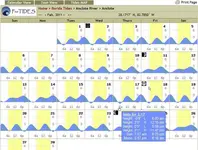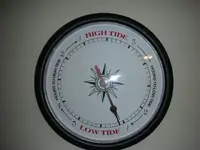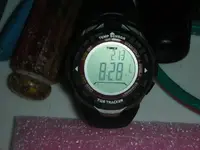You are using an out of date browser. It may not display this or other websites correctly.
You should upgrade or use an alternative browser.
You should upgrade or use an alternative browser.
Explain please
- Thread starter mumszie
- Start date
mumszie
Silver Member
- #3
Thread Owner
EZrider said:Mum, it's how many feet the tide will be high or low. I always look for a good negitive - low tide.
So on the first one............ it's 2 feet lower than normal?
and the second one ........it's 0.3 feet lower?
so what is the .............. -0.7
I know a minus is a good thing but I just don't understand what it means
stevemc
Bronze Member
- Joined
- Feb 12, 2005
- Messages
- 2,121
- Reaction score
- 279
- Golden Thread
- 0
- Location
- Sarasota, FL
- Detector(s) used
- Whites Surfmaster PI Pro and Whites Surfmaster PI, Minelab Excal NY blue sword. 2 White's Dual field pi, Garrett sea hunter pi II (but don't use it for obvious reasons) 5' x 3 1/2' coil underwater Pi
- Primary Interest:
- Shipwrecks
If it was 0.0, that is what is called mean low water, not necessarily low tide, but the average medium that they use for charting marine charts. So if it says the high hightide would be 3.0 and the low low tide would be -1.0 the difference would be 4 feet. Usually the high high is higher than the low low is low, because of this mean low water. There are usually 4 tides a day, seperated by a little less than 6 hours apart, like 15 minutes less, per tide, for a moon day of 23 hours, and a sun day of 24 hours. There is a high high and a lower high, and a low low and a not so low low. You have to watch that too. The moon has more pull on the tide, and the sun has some, but not as much. When the moon gets in phase with the sun, and rises and sets with the sun, and both go around pretty much together, which happens about 1 time every 45 days or so, it is called a Spring tide, and tides are stronger currents and higher and lower tides. Weak tides when the moon and sun are far apart, are called neap tides, and usually the 4 tide day is now almost a 2 tide day when it is a neap tide, and the tidal difference isnt as much as normal. This also happens about every 45 days. Also when a cold front or strong winds blow offshore and teams with a spring low, it is extremely low tide. And the opposite, when a hurricane blows on shore, and it is a spring high, it is very high. Just remember the tides are about an hour later each day, as the day before. So they are very predictable, but you have to know the variable which can effect the heights too. If it says low tide is 0.2, that means it is 2/10ths of a foot above mean low. -0.2 means 2/10ths below mean low. high is usually without a +, but low usually has a -, but not always.
OBN
Gold Member
- Joined
- Dec 30, 2008
- Messages
- 6,583
- Reaction score
- 7,139
- Golden Thread
- 0
- Location
- Maryland Waters
- 🏆 Honorable Mentions:
- 1
- Detector(s) used
- "Excalibur"..
"AQ" Impulse
- Primary Interest:
- Other
The best negitive tides are during the winter and around the full moon time, in the mid-atlantic states
http://www.protides.com/map/state-map.php?Florida
http://www.protides.com/map/state-map.php?Florida
Attachments
lookindown
Gold Member
The higher the number, the higher the water. The lower the number, the lower the water.
Montauk3
Hero Member
surfnturf
Bronze Member
Hi MZ  Hope all is well, haven't seen you post in a while! Around the full and new (or no moon) the tides are usually the strongest or they are Astronomically high and low that will go way out at low tide, I love it when its a - tide! All so this is the best time for storms, the high tide will cause beach erosion and hopefully sand removal and not sand build up! Hope this helps!!
Hope all is well, haven't seen you post in a while! Around the full and new (or no moon) the tides are usually the strongest or they are Astronomically high and low that will go way out at low tide, I love it when its a - tide! All so this is the best time for storms, the high tide will cause beach erosion and hopefully sand removal and not sand build up! Hope this helps!! 
 Hope all is well, haven't seen you post in a while! Around the full and new (or no moon) the tides are usually the strongest or they are Astronomically high and low that will go way out at low tide, I love it when its a - tide! All so this is the best time for storms, the high tide will cause beach erosion and hopefully sand removal and not sand build up! Hope this helps!!
Hope all is well, haven't seen you post in a while! Around the full and new (or no moon) the tides are usually the strongest or they are Astronomically high and low that will go way out at low tide, I love it when its a - tide! All so this is the best time for storms, the high tide will cause beach erosion and hopefully sand removal and not sand build up! Hope this helps!! THE SCURVY DOG
Greenie
HOLY SH&$!!
stevemc is there a test on this next Friday.................I think Im gonna be sick that day
! lol
lol
THE SCURVY DOG
Kevin M.
Santa Cruz CA.
stevemc is there a test on this next Friday.................I think Im gonna be sick that day
!
 lol
lolTHE SCURVY DOG
Kevin M.
Santa Cruz CA.
Dixie Digger
Hero Member
mlayers
Gold Member
- Joined
- Oct 29, 2007
- Messages
- 5,576
- Reaction score
- 429
- Golden Thread
- 0
- Location
- Northern, OH
- Detector(s) used
- DFX, White PI, Bounty Hunter, Whites Surfmaster II and Excalibur II
- Primary Interest:
- All Treasure Hunting
That looks real helpful. Can you get those for anywhere. I will be headed for Myrtle Beach at the end of March and the first of April so like to have one to see what time it would be best to hunt the beach......Matt
stevemc
Bronze Member
- Joined
- Feb 12, 2005
- Messages
- 2,121
- Reaction score
- 279
- Golden Thread
- 0
- Location
- Sarasota, FL
- Detector(s) used
- Whites Surfmaster PI Pro and Whites Surfmaster PI, Minelab Excal NY blue sword. 2 White's Dual field pi, Garrett sea hunter pi II (but don't use it for obvious reasons) 5' x 3 1/2' coil underwater Pi
- Primary Interest:
- Shipwrecks
You can find websites for most any area, and any date/year. Tides are so predictable, they have them set up way ahead. But remember what I said about all the varibles. They do figure the spring and neap tides in the charts too.
Dixie Digger
Hero Member
got mine off Ebay last year..there are a few on there now..i also have a Tide watch that works quite well.. http://cgi.ebay.com/TIDE-CLOCK-Comp...946?pt=LH_DefaultDomain_0&hash=item415479f8da
Attachments
As an eBay Associate we earn from qualifying purchases.
Similar threads
- Replies
- 17
- Views
- 1K
- Replies
- 17
- Views
- 1K
Users who are viewing this thread
Total: 1 (members: 0, guests: 1)








